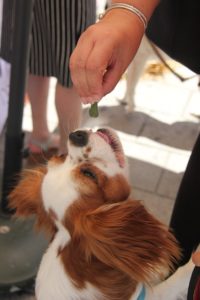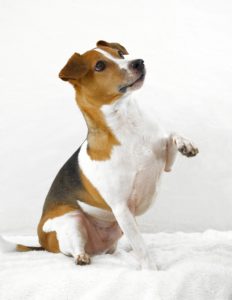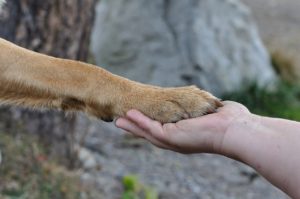Hi, my name’s Tiara and over 20 years as a trainer, I’ve trained 100’s of dogs!
One of the most common tricks to teach your dog is to “give a paw.”
Most people train “give a paw” (also called “shake”) for fun, but did you know there are are some practical reasons to teach this trick?
While some dogs are very comfortable being touched anywhere, others are opposed to having their paws handled.
Training “give a paw” will help when your dog’s paw needs to be examined or the nails need to be trimmed.
Preparing To Train
First of all, make sure your dog knows how to sit reliably. This trick is best trained while sitting, though once your dog is advanced you can teach give a paw while your dog is standing up or even laying down!
When your dog is in the sit position most of the weight is on the rear which makes it easy for the dog to lift a front leg.
In order to be successful, your dog should know to remain in the sit position until released, otherwise your dog will spring up when the reward is presented.

Reward Your Dog
Speaking of rewards, make sure to choose a small, easy to eat, high value treat when training. In other words, save the biscuits for another time. I prefer to use soft, smelly treats when training.
I do not give the dog these treats at any other time. I prefer hot dog or cheese. If you do not want to use “people food” find a soft training treat or use pieces of dog food roll cut up into small bites.
I am being repetitive about the treat being small, and for good reason. It takes a lot of treats to train a new trick. You can maximise the amount of extra food you provide to your dog by making it small.
Remember that dogs are not people and they aren’t concerned about the size of the treat. They simply want whatever that good smelling thing is in your hand!
If you are having a hard time keeping your dogs attention while training, it might be that the treat is not of high enough value.
Like people, dogs have preferences when it comes to things they like- and things they don’t- and a lazy dog might not be tempted to work for a training treat, but may be motivated for hot dog.
If your dog is overweight or prone to obesity, you can reduce the amount of food you give them at meals to compensate for the added food given during training time.
Training Space
Make sure your dog is in the right frame of mind for learning something new. Like you, if your dog is tired, too hungry, or has too much energy to focus, they are not going to be very receptive to training.
Training should always be a positive experience to maximise retention and keep your dog engaged. If you are trying to train when your dog is too hyper, it’s going to be a frustrating experience for you, and a potentially negative experience for your dog.
When first teaching your dog something new, try and minimize the amount of distractions. Children, other pets, guests coming over, meal time- all these things can make it harder for your dog to pay attention.
Eventually, once your dog has a firm grasp on the trick, you will want to ADD distractions, but in the beginning, try to train in a quiet place.
How To Teach Give A Paw
 There are several methods for teaching this trick, here I am going to discuss 2.
There are several methods for teaching this trick, here I am going to discuss 2.
I suggest you read through them both and choose the method that sounds like the best fit for how you train.
If you want to experiment with a new training method, this is a great trick to do so!
Method #1: Clicker Training to Give Paw
This is my preferred method as it is fast and highly effective. If you have already been clicker training with your dog, skip to step 2. For those of you who would like to experiment with this method, start at step 1.
To teach your dog using the clicker method, you will need a clicker (available at any pet store or online) and a lot of small treats.
The hardest part for newbies is learning to manage the treats while training. Some folks use a fanny pack, other their pocket, but the important thing to note is the food is out of view.
Step 1:
With your dog sitting or standing, click and then immediately present the reward. I typically have a handful of small, yummy treats in a closed fist where I can easily drop a treat after the click.
You will do this a lot! Click, treat. Click, treat. Do this until your dog has made the connection that the sound = reward. You will know when this has occurred because your dog will look at the hand that holds the food rather than the clicker.
For this trick, it’s ok if your dog tries to paw the reward hand, but do not click when the paw is raised. We do not want to confuse the dog with accidental training. It’s ok to move your hand out of the way, but make sure your dog is sitting calmly when working on this.
If your pooch can’t sit still, time for some exercise! Some dogs are naturally more hyper than others, and that’s ok, but for best retention, we want the dog to engage the mind.
If your dog has a hard time sitting still, evaluate your body position. Are you too far from your dog? This will make an excitable dog jump up to get closer to that yummy reward.
When you think your dog has got it, do it ten more times. Then take a break.
Step 2:
Your dog probably had a lot of fun with step 1, which is what we want! After a short break, start with the basics again (skip this if your dog is already trained to the clicker) to make sure your dog retained what he or she learned.
After the first click, your dog should keep attention on the reward hand (or your face) and seem happy. If your dog shows ANY confusion, go back to step 1.
In step 2 we start to shape the behavior- lift the paw. If your dog is the type to paw at the treat hand, you’re halfway there!
Keep treats in the same hand as the clicker. Show your dog the empty hand, some dogs may need to sniff the hand to reassure themselves there is no food. It’s ok.
With your empty hand, tap on your dog’s foot. At ANY sign of movement, click and reward. It should not take long for most dogs to realize what you want, but if your dog is having trouble,
DO NOT GET IMPATIENT! Just keep trying. If your dog gives up and walks away, go back to step 1.
In the beginning, it’s ok to tap the paw a few times, we’re not looking for perfection, we’re after movement of the foot.
Step 3:
When your dog starts lifting the paw with ease, you will add your marker word (such as shake, paw, give a paw).
Tap the paw and say your marker at the same time. When the dog moves the paw, click and reward.
Step 4:
Phase out the tap on the paw by just saying your marker word. If your dog lifts the paw, click and reward. Be sure to allow your dog some time to think about it.
Problem solving is a good thing! What you don’t want to do is keep repeating the word with no response.
If your dog doesn’t lift the paw after one or two tries with just the marker word, go back a step.
Once your dog reliably lifts the paw on the marker word alone, move on to the next step.
Step 5:
Now we’re going to put it all together. This part is tricky for you.
When you ask your dog to give the paw, put your empty hand in the way so the dogs raised paw touches your hand. At that moment, click.
Do this until your dog understands that the contact is what you want. When your dog reliably places the paw on your hand, start making it more difficult by placing your hand in different spots.

Method #2 Treat In Hand
This method is simple and typically easy to do.
You will have a treat in a fist and encourage the dog to paw at your hand to obtain the reward.
Ideally, you want your dog to be in the sitting position, but do not be discouraged if your dog pops up as it’s normal for a dog to dig while standing.
When your dog understands the trick you can pair it with sit.
Step 1:
Place a small, high value treat in your palm, show it to your dog, then make a fist.
Keep your fingers and the back of your hand facing downward.
Step 2:
Allow your dog to sniff your fist by placing it near the dogs knee.
Wait until your dog starts using the paw to open the hand.
Step 3:
When the dog places the paw on your hand, say your marker word and open your hand allowing the dog to obtain the reward.
Repeat this until your dog immediately places the paw on your hand without hesitation.
Step 4:
Once your dog understands the action, make a fist, but this time do not have food in your hand.
When your dog touches your hand on your mark, praise and then offer the reward from the other hand.
Step 5:
With your hand open and palm up, ask your dog for the paw.
If you find your dog stumbling at any step, go back and work on the previous step.
Final Thoughts
 Teaching your dog to give a paw is a fun, easy, and practical trick.
Teaching your dog to give a paw is a fun, easy, and practical trick.
If you find yourself or your dog struggling, remember to go back a step. It doesn’t hurt anything, in fact, it will build more confidence in your dog.
If you tried clicker training for the first time and enjoyed it, or if you would like to learn more fun things to do with clicker training, I suggest you check out Brain Training 4 Dogs.
This online dog training program is easy to follow, very affordable, and it presents training in a fun way. You can read my review of Brain Training 4 Dogs here.
Dog training should be an enjoyable activity. I hope you had a good time with this lesson on Give A Paw! Check back for more fun training articles and as always, enjoy the time you spend with your dog.

